
Ozothamnus is a genus of plants found in Australia, New Zealand and New Caledonia.

Calomeria is a plant genus in the family Asteraceae.
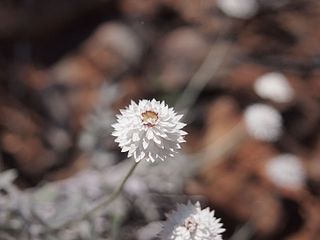
Anemocarpa is a genus of flowering plants in the family Asteraceae, endemic to Australia.

Pseudognaphalium luteoalbum, synonyms including Helichrysum luteoalbum, is a species of flowering plant in the family Asteraceae. In the United Kingdom, it is known the Jersey cudweed.

Ozothamnus ferrugineus, commonly known as tree everlasting, is a member of the genus Ozothamnus, of the Asteraceae family – one of the largest families of flowering plants in Australia. Native to the Australian states of New South Wales, Victoria, South Australia, and Tasmania, it forms an erect shrub or small tree between 2 and 3 metres in height.

Argentipallium is a genus of flowering plants in the family Asteraceae. The genus, which is endemic to Australia, was first formally described in 1992 by Paul G. Wilson in the botanical journal Nutsyia.
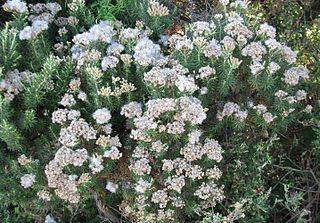
Ozothamnus turbinatus, the coast everlasting, is a shrub in the family Asteraceae, native to the states of New South Wales, Victoria, South Australia and Tasmania in Australia. It grows to between 1 and 2 metres in height.

Ozothamnus obcordatus, the grey everlasting, is a shrub in the family Asteraceae, native to the states of Queensland, New South Wales, Victoria and Tasmania in Australia.

Ozothamnus secundiflorus, the cascade everlasting, is an aromatic shrub species, endemic to Australia. It grows to between 0.5 and 2 metres in height. Leaves are 6 to 10 mm long and 1.5 to 4 mm wide. These are dark green with grey hairs on the upper surface, and white tomentose below. The white flower heads appear in dense clusters along one side of the stem between December and February in the species' native range.

Ozothamnus cupressoides is an aromatic shrub species, endemic to Australia. Common names include scaly everlasting, lattice everlasting or kerosene bush. It grows to between 0.5 and 1 metre in height and has white-tomentose branchlets. The scale-like leaves are 1 to 3 mm long and 0.5 to 1 mm wide. These are green on the upper surface, and white tomentose below. The flower heads appear in dense clusters in summer and autumn The species occurs in boggy sites and subalpine heathland in New South Wales and Victoria. It was first formally described in 2010 in the journal Muelleria.

Xerochrysum bicolor is a flowering plant in the family Asteraceae, native to Tasmania, where it is found in wetter habitats near the coast. It was originally described by Lindley in 1835 as Helichrysum bicolor, before gaining its current name in 2001.
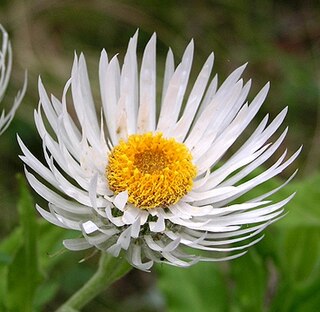
Coronidium boormanii is a perennial herbaceous shrub in the family Asteraceae found in Australia. Previously known as Helichrysum boormanii, it was given its new name in 2008.

Coronidium scorpioides, commonly known as the button everlasting, is a perennial herbaceous shrub in the family Asteraceae found in Australia. Previously known as Helichrysum scorpioides, it was placed in the newly described genus Coronidium in 2008.
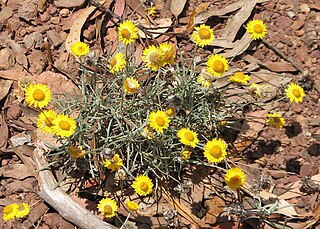
Leucochrysum albicans, commonly known as hoary sunray, is a species of plant in the family Asteraceae. It is endemic to Australia. It grows to 45 cm high and has grey-green woolly leaves that are between 2.5 and 10 cm long and 1 to 9 mm wide. The flowerheads appear between spring and summer. These have yellow centres surrounded by either white or yellow bracts.
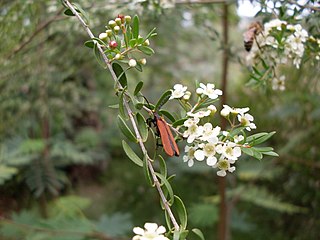
Sannantha pluriflora, commonly known as tall baeckea, is a flowering shrub or small tree species in the myrtle family, Myrtaceae. It is endemic to Australia. Plants grow to 4 metres high. White flowers appear in groups of three to seven between October and April in the species' native range. These have five rounded petals surrounding 8–15 stamens. The fruits are 2.5 to 3.5 mm in diameter.

Ozothamnus alpinus, commonly known as alpine everlasting, is a flowering plant in the family Asteraceae. It is endemic to alpine and subalpine areas in south-eastern continental Australia.

Ozothamnus cuneifolius, commonly known as wedge-leaf everlasting or wedge everlasting, is a shrub in the family Asteraceae. It is native to forests of the south-east of New South Wales and Gippsland in Victoria in Australia.
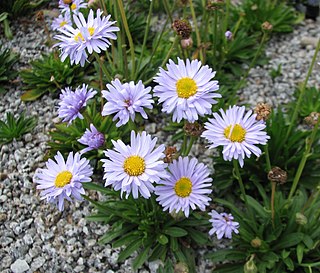
Brachyscome scapigera, commonly known as tufted daisy, is a perennial herb in the family Asteraceae. The species is endemic to south-eastern Australia.
Monotoca oreophila, the mountain broom heath, is a plant in the family Ericaceae. It is endemic to Victoria, Australia. Plants grow to between 0.2 and 2.5 metres high. The elliptic or lanceolate leaves are 3.8 to 11 mm long and 1.4 to 2.8 mm wide. They are stiff, convex and pointed at the apex. The upper surface of the leaves is dark green while the underside is white with distinct veins. White flowers appear between November and January in the species' native range. These are followed by fruits that ripen to orange-red between January and April.
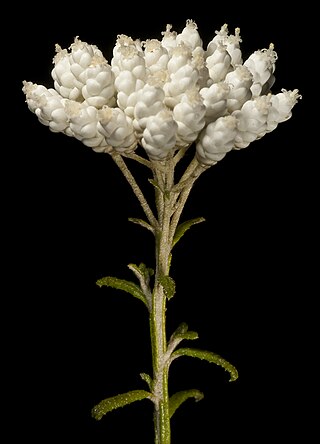
Ozothamnus occidentalis is a shrub in the family Asteraceae, native to Western Australia.



















